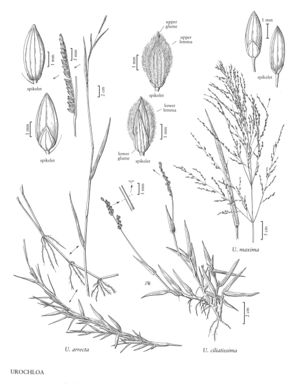Difference between revisions of "Urochloa arrecta"
FNA>Volume Importer |
imported>Volume Importer |
||
| Line 4: | Line 4: | ||
|publications= | |publications= | ||
|common_names=African signalgrass | |common_names=African signalgrass | ||
| + | |special_status={{Treatment/ID/Special_status | ||
| + | |code=I | ||
| + | |label=Introduced | ||
| + | }} | ||
|basionyms= | |basionyms= | ||
|synonyms= | |synonyms= | ||
| Line 38: | Line 42: | ||
|publication title= | |publication title= | ||
|publication year= | |publication year= | ||
| − | |special status= | + | |special status=Introduced |
| − | |source xml=https:// | + | |source xml=https://bibilujan@bitbucket.org/aafc-mbb/fna-data-curation.git/src/bb6b7e3a7de7d3b7888a1ad48c7fd8f5c722d8d6/coarse_grained_fna_xml/V25/V25_1331.xml |
|subfamily=Poaceae subfam. Panicoideae | |subfamily=Poaceae subfam. Panicoideae | ||
|tribe=Poaceae tribe Paniceae | |tribe=Poaceae tribe Paniceae | ||
Revision as of 22:01, 27 May 2020
Plants perennial; stoloniferous. Culms 50-120 cm, branching and rooting at the lower nodes; nodes glabrous. Sheaths glabrous, margins ciliate; ligules about 1 mm; blades 5-15 cm long, 7-15 mm wide, glabrous, bases subcordate, margins scabrous. Panicles (5)9-18(25) cm long, 3-4 cm wide, with 4-10(15) spikelike primary branches in 2 ranks; primary branches (1)2-5(10) cm, axes 0.5-2 mm wide, glabrous, margins scabrous; secondary branches rarely present, pedicels shorter than the spikelets, mostly scabrous, apices with hairs. Spikelets (3)3.3-4.4 mm long, 1.4-1.7 mm wide, ellipsoid, solitary, imbricate, in 2 rows, appressed to the branches. Glumes scarcely separated; lower glumes 1.5-1.8 mm, glabrous, 5-veined, not clasping the base of the spikelets; upper glumes 3.4-4.1 mm, glabrous, 7-veined; lower florets staminate; lower lemmas 3.4-4.1 mm, glabrous, 5-veined; upper lemmas 2.7-3.5 mm long, 1.3-1.6 mm wide, apices rounded, incurved; anthers 1.6-1.8 mm. 2n = unknown.
Distribution
Puerto Rico, Fla.
Discussion
Urochloa arrecta is native to Africa, but it has been introduced into Florida and Brazil as a forage grass. It is reported to be established in Collier County, Florida.
Selected References
None.
